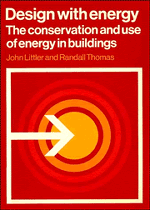Book contents
- Frontmatter
- Contents
- Units, symbols, abbreviations, conventions and conversion factors
- Preface
- 1 Energy and buildings
- 2 Site planning and analysis
- 3 Building design
- 4 Passive solar design
- 5 Active solar heating
- 6 Space heating and ventilation
- 7 Thermal storage
- 8 Wind energy
- 9 Water-supply systems
- 10 Waste disposal and utilization
- 11 Domestic-energy saving
- 12 Housing case studies
- 13 Non-domestic case studies
- Appendix 1 Weather data
- Appendix 2 Thermal performance
- Appendix 3 Interstitial condensation
- Index
4 - Passive solar design
Published online by Cambridge University Press: 03 February 2010
- Frontmatter
- Contents
- Units, symbols, abbreviations, conventions and conversion factors
- Preface
- 1 Energy and buildings
- 2 Site planning and analysis
- 3 Building design
- 4 Passive solar design
- 5 Active solar heating
- 6 Space heating and ventilation
- 7 Thermal storage
- 8 Wind energy
- 9 Water-supply systems
- 10 Waste disposal and utilization
- 11 Domestic-energy saving
- 12 Housing case studies
- 13 Non-domestic case studies
- Appendix 1 Weather data
- Appendix 2 Thermal performance
- Appendix 3 Interstitial condensation
- Index
Summary
Introduction
Most buildings receive sunlight via windows, and in the design of passively heated buildings this warming effect is more fully exploited.
The five tasks to be accomplished in a successful design are as follows:
to increase the amount of sunlight entering the building by enlarging the glazed area;
to avoid causing excessive overheating or glare;
to reduce the large heat loss through the glazing;
to distribute the heat acquired;
to store the surplus for use when the sun stops shining.
There has been some sterile argument about terminology.' “Passive” and “natural” solar designs' are terms coined to differentiate the use of sunlight which provides warmth without the use of complicated controls, pumps and fans, from ‘active solar designs’ which employ solar collectors and fairly complex controls. The meaning of the terms will become more clear whilst reading the descriptions of the built examples later in this and the following chapters.
It is of interest to realize that active solar systems associated with very large thermal storage could be used to provide all the space heating and hot water in a building, even in the UK. On the other hand, passive designs can never be expected to do this in northern Europe, and there they must be regarded as fuel savers. In the US and other countries blessed with moreintense and regular winter sunshine, it is possible in cold but clear regions to rely entirely on passive solar space heating. Apart from the number of sunny days in a particular region, there are other constraints acting on the design team when dealing with passive solar buildings.
- Type
- Chapter
- Information
- Design with EnergyThe Conservation and Use of Energy in Buildings, pp. 97 - 158Publisher: Cambridge University PressPrint publication year: 1984



